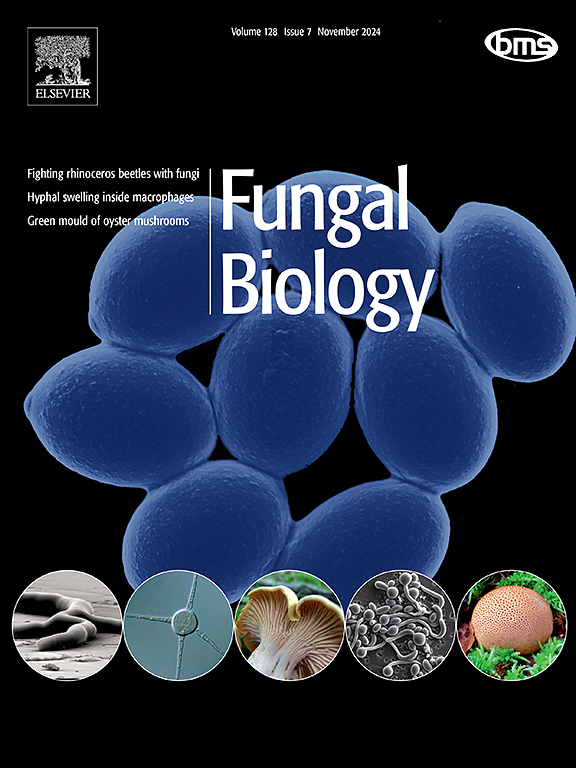Light enhances the production of conidia and influences their hydrophobicity in Tolypocladium inflatum
IF 3
3区 生物学
Q2 MYCOLOGY
引用次数: 0
Abstract
Insect fungal pathogens such as Beauveria bassiana, Metarhizium robertsii, and Tolypocladium inflatum have been used as insect biocontrol agents. Their infection mechanism involves non-specific adhesion to the host cuticle, which is controlled by hydrophobins, small proteins that form an amphipathic monolayer with rodlet morphology on diverse fungal structures. Light is an abiotic factor that may influence a wide range of cellular processes, including conidiogenesis, stress tolerance, and metabolite biosynthesis. Although its effects have been studied in many fungi, little is known about the effects of light on the hydrophobic properties of conidia. The aim of this work was to investigate the influence of visible light on the conidial hydrophobicity of three entomopathogenic fungal species. For this, conidia of B. bassiana, M. robertsii, and T. inflatum were grown either under light or in the dark, drop profiles of water and diiodomethane on conidial surfaces were analyzed, and conidial hydrophobicity was estimated from contact angle measurements. Moreover, conidial production was determined, and their genome was screened with sequences for hydrophobins. Conidia of B. bassiana and M. robertsii are more hydrophobic than conidia of T. inflatum. The light modified the surface tension of T. inflatum; therefore, conidia of T. inflatum became hydrophilic. However, light did not affect the conidial hydrophobicity of B. bassiana and M. robertsii. In addition, light modified the conidial production of B. bassiana and T. inflatum cultures, but it had no effect on the conidial production of M. robertsii. The T. inflatum genome contains two predicted proteins whose sequence is akin to that of proven class II hydrophobins from other ascomycetes. Presumably, these proteins are responsible for the conidial hydrophobicity properties in this fungus. Our study helps elucidate how light affects the conidial hydrophobicity of entomopathogenic fungi.
光能促进疫霉菌分生孢子的产生并影响其疏水性
昆虫真菌病原体如球孢白僵菌、罗伯特绿僵菌和膨胀霉霉已被用作昆虫生物防治剂。它们的感染机制包括与宿主角质层的非特异性粘附,这是由疏水蛋白控制的,疏水蛋白是一种小蛋白质,在不同的真菌结构上形成具有小颗粒形态的两亲性单层。光是一种非生物因素,可以影响广泛的细胞过程,包括孢子形成、应激耐受性和代谢物生物合成。虽然光在许多真菌中的作用已经被研究过,但人们对光对分生孢子疏水特性的影响知之甚少。研究了可见光对三种昆虫病原真菌分生孢子疏水性的影响。为此,研究了球孢酵母、robertsii和T. inflatum三种真菌的分生孢子在光照和黑暗条件下生长,分析了水和二碘甲烷在分生孢子表面的水滴分布,并通过接触角测定了分生孢子的疏水性。此外,还测定了分生孢子的产生,并用疏水蛋白序列筛选了它们的基因组。球孢白僵菌和robertsii白僵菌的分生孢子比膨体白僵菌的分生孢子更疏水。光照改变了膨松菌的表面张力;因此,膨胀菌的分生孢子具有亲水性。而光对球孢白僵菌和绿僵菌的分生孢子疏水性没有影响。此外,光照对球孢白僵菌和膨胀菌的分生孢子产量有影响,但对robertsii的分生孢子产量没有影响。膨胀t基因组包含两种预测的蛋白质,其序列与其他子囊菌中已证实的II类疏水蛋白相似。据推测,这些蛋白质对这种真菌的分生孢子疏水性负有责任。我们的研究有助于阐明光如何影响昆虫病原真菌的分生孢子疏水性。
本文章由计算机程序翻译,如有差异,请以英文原文为准。
求助全文
约1分钟内获得全文
求助全文
来源期刊

Fungal biology
MYCOLOGY-
CiteScore
5.80
自引率
4.00%
发文量
80
审稿时长
49 days
期刊介绍:
Fungal Biology publishes original contributions in all fields of basic and applied research involving fungi and fungus-like organisms (including oomycetes and slime moulds). Areas of investigation include biodeterioration, biotechnology, cell and developmental biology, ecology, evolution, genetics, geomycology, medical mycology, mutualistic interactions (including lichens and mycorrhizas), physiology, plant pathology, secondary metabolites, and taxonomy and systematics. Submissions on experimental methods are also welcomed. Priority is given to contributions likely to be of interest to a wide international audience.
 求助内容:
求助内容: 应助结果提醒方式:
应助结果提醒方式:


